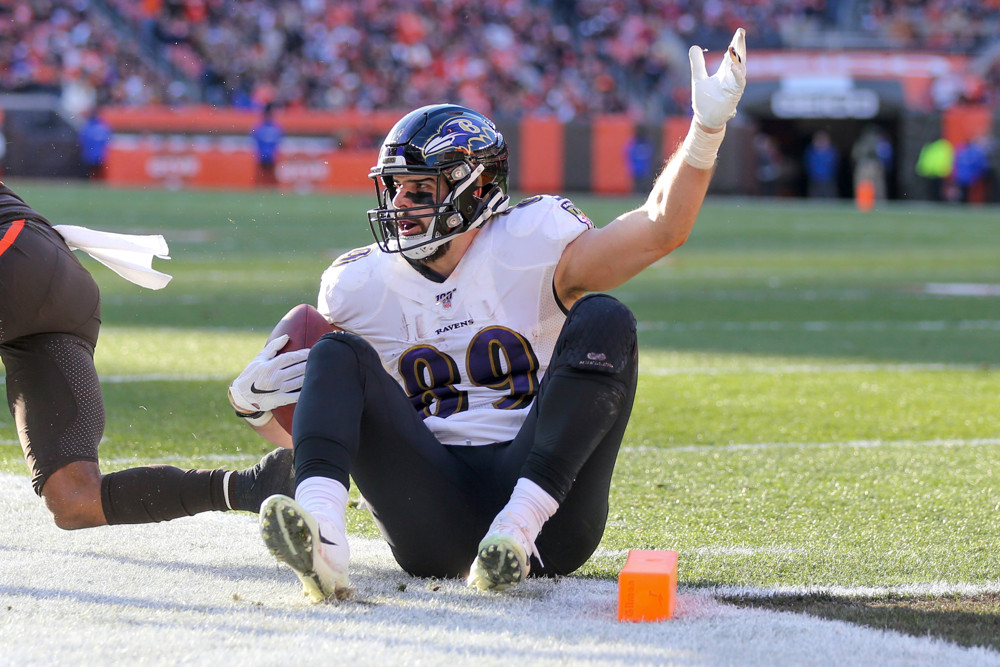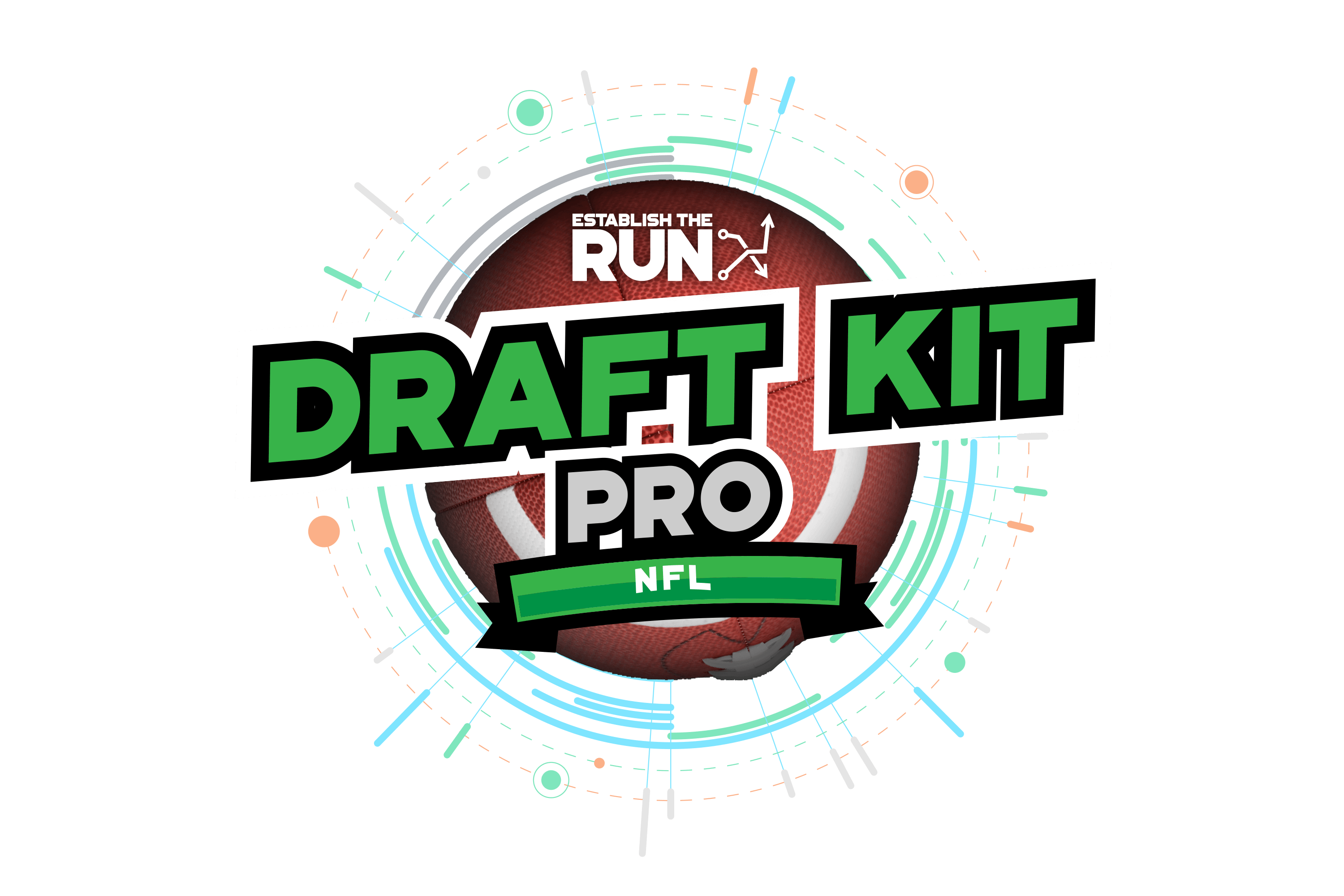The NFL Draft is officially in the rearview mirror. Best Ball Mania 3 — with a $10 million prize pool! — launched today.
And that means it’s time for us to start drafting (well, maybe). It is best ball summer once again — arguably the best time of the year. There will be Zero RB wars on Twitter, hype trains on players who never see the field, and myriad analyses that will be rendered useless by midseason as we try to predict during the dog days of summer what will transpire in December and January.
Underdog Fantasy has emerged as perhaps the most popular mainstream best ball platform, and they are generous enough to publicly publish their previous-season data for everyone to interpret. Today, we’ll dig into that data to roughly examine the optimal drafting strategies from 2021 and see how last year’s results compared with those from 2020.
Before we do that, it’s critical to remember that we are only looking at one year of data, and many trends that look like macro-level principles are really just caused by a small number of individual player outcomes. For example, today we’ll be defining an “early” pick as one used within the first five rounds. (We’ll have more nuanced analysis in the coming weeks and months; this is merely meant to serve as an overview of what worked last season as well as a conversation starter.) That means any roster construction analysis looking at early-round tight ends is really only looking at Travis Kelce, Darren Waller, George Kittle, Kyle Pitts, and (sometimes) Mark Andrews. Anything centered around early-round quarterbacks is just looking at how teams with Patrick Mahomes, Josh Allen, Kyler Murray, Lamar Jackson, and (sometimes) Dak Prescott performed. With that in mind, let’s revisit some basic roster construction questions Mike Leone answered last May using 2020 data. Namely:
- How many of each position should you draft?
- What positions should you draft early?
- How can you draft dynamically?
Now, let’s see what the data is telling us about last season.
OVERALL ROSTER CONSTRUCTION
Let’s first take a bird’s-eye view of all constructions, filtering out those that weren’t used at least 100 times.
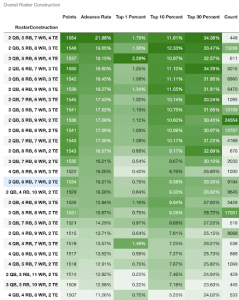
Advance Rate signifies the rate at which teams with a certain construction advanced out of the group stage. Top 1 Percent, Top 10 Percent, and Top 30 Percent demonstrate how often each construction finished in the Top X Percent. For example, 2.29% of teams with a 3-5-6-4 build finished in the Top 1 Percent. All charts are sorted by Advance Rate.
There were only two builds that featured four tight ends that had at least 100 teams — and both were among the three most successful in terms of Advance Rate. This is a stark contrast from 2020 when the only 4-TE build with at least 100 teams had an estimated 5.7% league win rate, and three of the top four builds had just two tight ends. That dichotomy between two years is a perfect example of why it’s so dangerous to take any of these numbers at face value. Nothing really changed between 2020 and 2021 to make it smarter to take more tight ends; it’s not like the NFL shifted dramatically in a way that would benefit TE-heavy constructions.
Rather, the most likely explanation is that early-round TEs underperformed last season, and teams who took a tight end early likely stopped at two (or, at most, three). Kelce (13.0%), Waller (11.2%), and Pitts (13.0%) all had firmly below-average advance rates, and they made up three of the four TEs who nearly unanimously went in the first three or four rounds. Kittle (19.4%) was above average in that regard, but it still tracks that teams who took one early — and were less likely to take multiple TEs later as a result — struggled. On the contrary, guys like Dawson Knox, Zach Ertz, and Pat Freiermuth all went right at the end of drafts and could have been part of a 4-TE group for best ball players who forwent the position until the very end.
It’s also possible drafters felt pressured to only take two TEs given the low-scoring nature of the position and ended up overly fragile because of it. This mindset could also have pushed down the TE ADP as a whole, creating better value for those who waited and then stocked up in the double-digit rounds.
Regardless, Kelce underperforming and Knox overperforming relative to ADP should not entice you to draft more 4-TE teams in 2022. Instead, it should serve as an example of how many macro-level trends are simply a result of individual player outcomes. This is especially true at QB and TE, but it’s true for all positions when we’re looking at a sample of one or two years. The 4-TE builds had sample sizes of 448 and 611, respectively, furthering the notion that their success is noisy rather than the start of a new trend.
The noise with this data is also apparent when you look at how subtle differences in construction caused major differences in results. For example, teams with 2 QBs, 5 RBs, 7 WRs, and 4 TEs had the highest win rate of any build at 21.88%. However, teams with 3 QBs, 5 RBs, 7 WRs, and 3 TEs were only slightly above average at 17.52%. It’s unlikely that drafting one more quarterback over a tight end is momentous enough to drop your expected win rate by more than four percentage points, but that’s how things played out last season. That type of difference from a relatively meaningless change in the grand scheme of things — a QB3 or TE4 is unlikely to contribute much anyway — is something else to keep in mind with this data.
Still, just because we need a healthy dose of context when examining this data doesn’t mean it’s useless. Let’s go position-by-position to break down what we can learn from 2021 in terms of roster construction.
POSITION-BY-POSITION BREAKDOWN
QUARTERBACK
First, let’s take a look at team success simply based on how many quarterbacks they drafted.
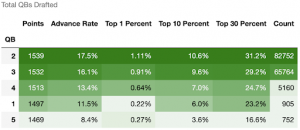
For the second year in a row, 2-QB teams outperformed their 3-QB counterparts. The difference between teams with two vs. three signal callers wasn’t massive, but it was noteworthy, especially for something broad like this. Leone had similar findings when he did this article last year: Teams with two QBs had a higher estimated win rate (8.74% vs. 8.01%), League Top 3 Rate (25.28% vs. 25.01%), and Top 1% Rate (1.11% vs. 0.88%). We have different metrics this year since Underdog provided the more pertinent Advance Rate, but the conclusion remains the same: Drafting two quarterbacks has been better than drafting three. And there’s almost no reason to take more than three quarterbacks, as win rates predictably plummet when drafters dedicate four picks to a position that can only fill one slot each week.
Of course, we also have to consider when it’s most optimal to take quarterbacks. Keeping in mind that this is basically just looking at how Mahomes, Allen, Lamar, Murray, and (sometimes but not usually) Prescott performed last year, let’s take a look at how teams who spent a pick in the first five rounds on a QB did in 2021.

Teams that didn’t take a QB early advanced at a slightly higher rate, although the difference wasn’t so wide that it warrants completely fading all early-round QBs in 2022. Interestingly, squads without an early-round QB finished in the Top 1% of all teams 1.07% of the time vs. just 0.87% of the time for those who gambled on a signal caller early. That’s a difference worth keeping an eye on, although it’s hardly definitive with just a one-year sample. This was the second year in a row that it was wiser to wait past the first five rounds on QB, although the difference was much smaller than it was in 2020, likely because Allen was so dominant as an early-round option.
Next, let’s take a look at teams that picked their first QB in Rounds 6-10.

This group had a 17.3% Advance Rate in 2021, as guys like Tom Brady, Justin Herbert, and Aaron Rodgers emerged from the middle rounds to finish as top-six options. Mid-round QBs were also successful in 2020, posting an estimated 9.9% win rate. The gap was not as big this past season — likely because early-round QBs (read: Josh Allen) were so much more successful than they were in 2020 — but it still seems like Rounds 6-10 is a solid time to take your first quarterback.
Because you sure don’t want to wait any longer than that.

Teams that took their QB1 in Round 11 or later advanced at just an 11.8% rate — well below the baseline of 16.7%. It was a similar story in 2020 when teams that waited on QB won their league just 6.8% of the time. Waiting on QB has become the most widely accepted strategy in casual redraft leagues, but it’s not wise to do so in best ball. You want to leave the first 10 rounds with at least one QB on your roster. Underdog’s Hayden Winks penned an article earlier this offseason about why QBs are undervalued on this platform, and this data, while admittedly bare-bones, would agree. Hayden pointed out how half-PPR best ball increases the value of QBs relative to other positions as it’s the only position unaffected by not rewarding a reception with a full point. Anecdotally, QB ADP has also sharpened in recent years as fantasy players become more privy to the advantage of rushing and the upside of younger breakout options. Gone are the days of getting Year 2 Lamar Jackson and Patrick Mahomes outside the top 12 QBs. It’s not always going to work out — see Trey Lance and Justin Fields last year — but ADP now more accurately represents the value of youth and rushing and the QB position. The Konami Code is no longer a secret, at least on a platform like Underdog that hosts some of the savviest best ball players in the world.
Notes:
- You want to grab your first QB within the first 10 rounds. Over the past two years, Rounds 6-10 have been a solid spot to nab your QB1, although it’s also viable to take one in the first five rounds if that’s how the board falls.
- You’ll want to finish your draft with either two or three QBs, and two has been preferable to three over the past two years. It’s not viable to take only one QB or to select more than three. You also want to remain dynamic when drafting; if you miss out on the top-12 QBs, perhaps it makes more sense to take three. If you take a QB in the first five rounds, you don’t need more than two.
RUNNING BACK
We’ll start off by looking at team success based on how many RBs they took and how many they took early (within the first five rounds).
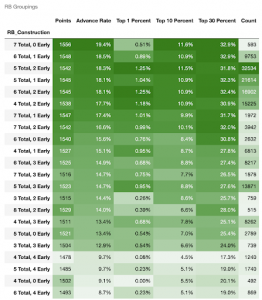
The key appears to be not overdosing on running backs in the first five rounds. The highest win rate among any construction that took 3+ early RBs was 14.9%. The bottom half of the table above is littered with builds that took three or four runners in the first 60 picks. In 2020, some of these builds were fairly successful, especially when they stopped at only four running backs total. For the most part, more classic builds were favored in 2021, as only one 4-RB build had an above-average win rate. On the flip side, Zero RB builds performed well from an advancement perspective but didn’t score in the Top 1% of regular-season scores very often. Teams that had 7 RBs but 0 early RBs had an awesome 19.4% Advance Rate, but only placed in the Top 1% 0.51% of the time. Similarly, teams with 6 RBs but 0 early RBs had a slightly below-average 15.6% win rate but finished in the Top 1% 0.76% of the time, a tick lower than many of the other builds with similar advancement rates.
We’ll dig deeper into this soon — this article is just meant to start the conversation and serve as a larger overview of roster construction in 2021 — but the idea of a “running back dead zone” really took off last summer and affected ADP such that very few RBs were selected in Rounds 3-6. A quick look back shows that 15 RBs had an ADP within the first two rounds and then only 11 RBs had an ADP in Rounds 3-6. That means that many of the teams with early RBs (first five rounds) were likely taking their RBs very early (in the first two rounds). Considering many WRs emerged as league-winners from Rounds 3-6 in 2021, that could indicate that taking an RB or two right away and then loading up on WRs before backfilling with RBs is optimal. At the same time, context is key once again: I’m sure starting with two RBs will appear optimal simply because Calvin Ridley, DeAndre Hopkins, DK Metcalf, and A.J. Brown all far underperformed ADP last year. Teams that took an RB instead of one of the early WR traps were sitting pretty, especially since Round 2 RBs like Joe Mixon, Austin Ekeler, and Najee Harris were significantly better than the average second-round backs of years past, and that will almost certainly be reflected in the win rate data.
RB strategy requires more nuanced analysis than just looking at the number of RBs taken and the number in the first five rounds, but a quick look shows that taking a runner or two early and then taking around five is the most reasonable approach. That’s not groundbreaking information, but it warrants reinforcing.
Notes:
- You don’t want to set a hard and fast rule for yourself, but typically teams that draft more than two running backs in the first five rounds don’t perform well.
- 4-6 RBs is the sweet spot for how many runners you should draft, and the exact number you should take depends on what you do in the early rounds. If you start RB-RB, you can get away with four or five. If you only take one early or fully embrace the Zero RB lifestyle, it makes more sense to take five or six backs.
WIDE RECEIVER
Let’s look at how teams did last year based on how many WRs they took total and in the first five rounds.
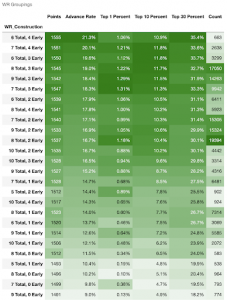
This data is fairly correlated to the running back data considering the majority of players drafted (and drafted early) are either a running back or wide receiver. As such, it’s no surprise that drafting three or four wideouts in the first five rounds was highly successful, and in fact, the two most potent strategies in terms of Advance Rate featured four receivers in the first five rounds. There exists a notion that you can simply wait on WRs and count on spike weeks to scrounge enough points at the receiver position, but at this point, there is ample evidence suggesting it’s wise to load up on wideouts early and often. 2021 was no exception.
In 2020, the two strategies with the highest estimated league win rate had 10 WRs. This past season, 10-WR builds didn’t fare as well, with the two most popular 10-WR builds (10 WRs with two early and 10 with three early) both advancing at a merely average rate, while those who drafted four or one early WRs struggled mightily.
On the whole, a major difference between 2020 and 2021 was how many total RBs vs. WRs to draft. In 2020, more extreme builds featuring bulk WRs and fewer RBs performed well. Last season, more balanced builds did better, perhaps because late-round dart-throw WRs didn’t perform as well. It’s also important to keep in mind that hyperfragile drafting gained major steam last summer to the point where it was no longer contrarian. Because of that, it’s possible early-round RB and late-round WR ADPs were pushed up as drafters forced hyperfragility even when it wasn’t optimal. This will be something to watch moving forward, but one thing remains clear across both years: Do not overload on RBs early, and you usually want to leave the first five rounds with at least three wideouts. WRs aren’t as valuable on Underdog as they are on full-PPR platforms, but it’s worth mentioning that this supports years of research on Fanball and FFPC leagues. You don’t want to skimp out on WRs in the early rounds, even though it may seem as though you can simply spam WRs in the later rounds and get points that way. Quantity isn’t necessarily a bad option at WR, but it shouldn’t be at the expense of early-round quality.
Notes:
- You typically want somewhere between 7-10 WRs, and the exact optimal strategy once again depends on what you do in the early rounds. You need more total wideouts if you go lighter at receiver early.
- You usually want to leave the first five rounds with at least two (and, more often, three or four) wide receivers. One might intuitively think that you can use quantity to make up for a lack of quality at wideout given the reliance on spike weeks in best ball, but years of data indicate that’s not the case.
TIGHT END
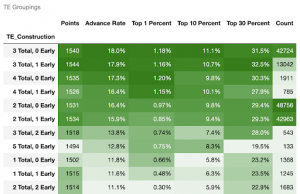
For the second year in a row, double-early-TE was not a lucrative strategy. Part of this is because ADP made it so the two early TEs were either Waller and Kittle or Kelce and Pitts, but it’s also true that TE is the lowest-scoring position and it’s usually better to have a WR in your flex spot instead; although the argument of positional scarcity is an interesting one. Still, TEs have elevated injury rates compared to WRs and score significantly fewer points, so you’ll probably want to avoid spending a ton of draft capital on two elite TEs.
As we talked about earlier, 4-TE builds were successful last year, although there is a lot of reason to be skeptical that repeats in 2022. In general, I don’t think it makes sense to shift our thinking around the TE position too much because of a one-year sample when many of the macro-level results can be explained by individual outcomes. For example, Mark Andrews had the second-highest advancement rate (28.4%) among all tight ends last season — narrowly behind Rob Gronkowski — and his 59.0 ADP indicates he was sometimes taken in the first five rounds and sometimes not, so it’s hard to decipher some of this information with that in mind. 2-TE builds struggled compared to 2020, which could be an indicator of the number of successful late-round options (teams with 3-4 TEs may have been more inclined to take more shots late in hopes of hitting one, whereas 2-TE teams probably didn’t take a late guy unless they also had an early TE, and we know early-round TEs underperformed). On the whole, I’m not altering my TE strategy too much based on this information.
Notes:
- Most teams should finish with either two or three total tight ends. If you take one early, you’re probably fine with two, whereas you might want to take a TE3 if you don’t get one of the high-end options at the position.
- You also don’t want to dedicate too many roster spots to the onesie positions – QB and TE – so taking three TEs is more viable if you only have two QBs, and vice versa.
- Over the past two seasons, taking two elite tight ends has not been a successful strategy on Underdog.
